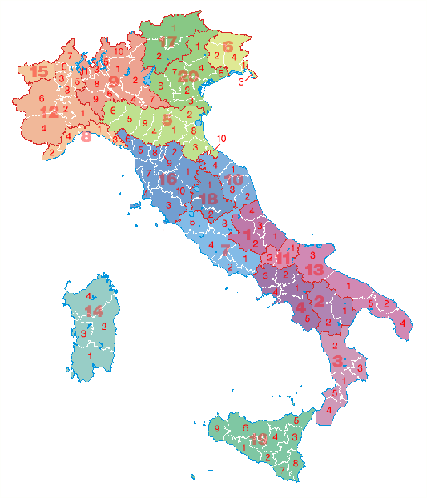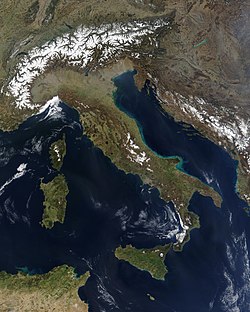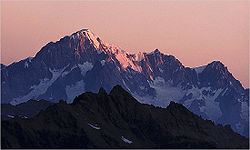
|
|
Italy (Italian: Repubblica
Italiana or Italia) is a country
in southern Europe. It comprises
a boot-shaped peninsula
and two large islands in the Mediterranean
Sea, Sicily
and Sardinia, and shares
its northern alpine boundary with France,
Switzerland, Austria
and Slovenia. The independent
countries of San Marino
and the Vatican City
are enclaves within
Italian territory.
For more than 3,000 years Italy
witnessed many migrations and invasions from Germanic,
Celtic, Frankish,
Byzantine Greek, Norman,
and the French Angevin,
and Lombard peoples.
Italy was also home to many well-known and influential
civilisations, including the Etruscans,
Greeks and the Romans.
Italy is called Belpaese (Italian for
beautiful country) by its inhabitants,
due to the beauty and variety of its landscapes
and for its world's largest artistic patrimony;
the country is home to the greatest number of
UNESCO World Heritage
Sites (40 until January 1,
2006).
Presently, Italy is a highly
developed country with the 6th GDP
in 2004, a member of G8
and a founding member of what is now the European
Union signing the Treaty of Rome
in 1957.
Inhabitants of Italy are referred
to as Italians (Italian:
Italiani). There exist several theories concerning
the origin of the name Italia, but the
most widely believed etymology
is that it is derived from the ancient Greek word
italos (bull).

History of Italy
Italy has influenced the cultural
and social development of the whole Mediterranean
area, deeply influencing European
culture as well. Important cultures
and civilizations have existed there since prehistoric
times. After Magna Graecia,
the Etruscan civilization
and especially the Roman Republic
and Empire that dominated
this part of the world for many centuries, Italy
was central to European science and art during
the Middle Ages and
Renaissance.
Modern Italy became a nation-state
belatedly — on March 17,
1861, when most of the
states of the peninsula were united under king
Victor Emmanuel II of
the Savoy dynasty, which
ruled over Sardinia
and Piedmont. The architects
of Italian unification were Count
Camillo Benso di Cavour, the Chief
Minister of Victor Emmanuel, and Giuseppe
Garibaldi, a general and national
hero. Rome itself remained
for a little less than a decade under the Papacy,
and became part of the Kingdom of
Italy only on September
20, 1870.
The Vatican is now an
independent enclave surrounded by Rome.

Politics
The 1948 Constitution
of Italy established a bicameral
parliament (Parlamento),
consisting of a Chamber of Deputies
(Camera dei Deputati) and a Senate
(Senato della Repubblica), a separate
judiciary, and an executive
branch composed of a Council of
Ministers (cabinet)
(Consiglio dei ministri), headed by the
prime minister (Presidente
del consiglio dei ministri).
The President of
the Republic (Presidente della
Repubblica) is elected for seven years by
the parliament sitting jointly with a small number
of regional delegates. The president nominates
the prime minister, who proposes the other ministers
(formally named by the president). The Council
of Ministers must retain the support (fiducia)
of both houses.
The houses of parliament
are popularly and directly elected through a proportional
representation system. The Chamber of Deputies
has officially 630 members (de facto,
619 only after the 2001 elections). In addition
to 315 senators, elected members, the Senate includes
former presidents and several other persons (no
more than five) appointed for life by the President
of the Republic according to special constitutional
provisions. Both houses are elected for a maximum
of five years, but both may be dissolved before
the expiration of their normal term. Legislative
bills may originate in either house and must be
passed by a majority in both. The Italian judicial
system is based on Roman law
modified by the Napoleonic code
and later statutes.
A constitutional court, the Corte Costituzionale,
passes on the constitutionality of laws, and is
a post-World War II
innovation.
All Italian citizens older than
18 can vote. However, to vote for the senate,
the voter must be at least 25 or older.
Administrative divisions
Italy is subdivided into 20 regions (regioni,
singular regione). Five of these regions
enjoy a special autonomous status
that enables them to enact legislation on some
of their specific local matters, and are marked
by an *:
- Abruzzo (with capital
L'Aquila)
- Basilicata (Potenza)
- Calabria (Catanzaro)
- Campania (Naples,
Napoli)
- Emilia-Romagna (Bologna)
- Friuli-Venezia Giulia*
(Trieste)
- Latium, Lazio
(Rome, Roma)
- Liguria (Genoa,
Genova)
- Lombardy, Lombardia
(Milan, Milano)
- Marches, Marche
(Ancona)
- Molise (Campobasso)
- Piedmont, Piemonte
(Turin, Torino)
- Apulia, Puglia
(Bari)
- Sardinia*, Sardegna
(Cagliari)
- Aosta Valley*, Valle
d'Aosta / Vallée d'Aoste (Aosta,
Aoste)
- Tuscany, Toscana
(Florence, Firenze)
- Trentino-South Tyrol*,
Trentino-Alto Adige/Südtirol Trento,Bolzano)
- Umbria (Perugia)
- Sicily*, Sicilia
(Palermo)
- Veneto (Venice,
Venezia)
All regions except the Aosta Valley are further
subdivided into two or more provinces.


Foreign relations
Italy was a founding member of
the European Community—now the European
Union (EU). Italy was admitted to the
United Nations in 1955 and is
a member and strong supporter of the North
Atlantic Treaty Organization (NATO),
the Organisation for Economic Co-operation
and Development (OECD), the General
Agreement on Tariffs and Trade/World
Trade Organization (GATT/WTO), the Organization
for Security and Co-operation in Europe
(OSCE), and the Council of Europe.
Its recent turns as rotating Presidency of international
organisations include the CSCE
(the forerunner of the OSCE) in 1994 G8,
the EU in 2001 and from July to December 2003.
Italy supports the United Nations and its international
security activities. Italy deployed troops in
support of UN peacekeeping missions in Somalia,
Mozambique, and East Timor and
provides support for NATO and UN operations in
Bosnia, Kosovo
and Albania. Italy deployed over
2,000 troops to Afghanistan in
support of Operation Enduring Freedom (OEF) in
February 2003. Italy still supports international
efforts to reconstruct and stabilize Iraq,
but it has withdrawn its military contingent
of some 3,200 troops as of November 2006, maintaining
only humanitarian workers and other civilian personnel.
In August 2006 Italy sent about 3,000 soldiers
to Lebanon for the ONU
peacekeeping mission UNIFIL. Furthermore,
since 2 February 2007 an Italian,
Claudio Graziano is the commander
of the UN force in the country.

Military
Article 11 of the Italian
Constitution says: "Italy rejects war
as an instrument of aggression against the freedoms
of others peoples and as a means for settling
international controversies; it agrees, on conditions
of equality with other states, to the limitations
of sovereignty necessary for an order that ensures
peace and justice among Nations; it promotes and
encourages international organizations having
such ends in view".
The Italian armed forces are
under the command of the Italian Supreme Defense
Council, presided over by the President
of the Italian Republic. The total number
of military personnel is approximately 308,000.
Italy has the eighth-highest military expenditure
in the world.
The Italian armed forces are
divided into four branches: Army,
Navy, Air Force
and Gendarmerie.

Geography
Italy occupies a long, boot-shaped peninsula,
surrounded on the west by the Tyrrhenian
Sea and on the east by the Adriatic
Sea. It is bounded by France, Switzerland,
Austria, and Slovenia to the
north. The Apennine Mountains
form the peninsula's backbone; the Alps
form its northern boundary. The largest of its
northern lakes is Garda (143
sq mi; 370 km²); the Po, its
principal river, flows from the Alps on Italy's
western border and crosses the Padan
plain to the Adriatic Sea. Several
islands form part of Italy; the largest are
Sicily (9,926 sq mi; 25,708
km²) and Sardinia (9,301 sq
mi; 24,090 km²).
There are several active volcanoes
in Italy: Etna, the largest active
volcano in Europe; Vulcano; Stromboli;
and Vesuvius, the only active
volcano on the mainland of Europe.
Italy consists predominantly of a large peninsula
(the Italian Peninsula)
with a distinctive boot shape that extends into
the Mediterranean Sea,
where together with its two main islands Sicily
and Sardinia it creates
distinct bodies of water, such as the Adriatic
Sea to the north-east, the Ionian
Sea to the south-east, the Tyrrhenian
Sea to the south-west and finally
the Ligurian Sea to
the north-west.
The Apennine mountains
form the backbone of this peninsula, leading
north-west to where they join the Alps,
the mountain range that then forms an arc enclosing
Italy from the north. Here is also found a large
alluvial plain, the Po-Venetian plain, drained
by the Po River —
which is Italy's biggest river with 652 km —
and its many tributaries flowing down from the
Alps (Dora
Baltea, 160 km, Sesia,
138 km, Ticino, 248
km, Adda, 313 km,
Oglio, 280 km, Mincio),
194 km, and Apennines
(Tanaro, 276 km, Trebbia,
115 km, Taro, 115
km, Secchia, 172 km,
Panaro, 148 km).
Other well-known or importants rivers include
the Tiber (Tevere)
(405 km), Adige (410
km), Arno (241 km),
Piave (220 km), Reno
(212 km), Volturno
(175 km), Tagliamento
(170 km), Liri-Garigliano
(158 km), Isonzo (136
km).
Its highest point is Mont Blanc
(Monte Bianco) at 4,810 metres
(15,781 feet)3.
Italy is more typically associated with two
famous volcanoes:
the currently dormant Vesuvius
near Naples and the
very active Etna on
Sicily.

Climate
The Italian climate is uniquely diverse and
can be far from the stereotype of a "land of
sun", depending on the region. The north of
Italy (Turin, Milan, and Bologna) has a true
continental climate, while below Florence it
becomes more and more Mediterranean. The climate
of the coastal areas of the Peninsula is very
different from that of the interior, particularly
during the winter months. The higher areas are
cold, wet, and often snowy. The coastal regions,
where most of the large towns are located, have
a typical Mediterranean climate with
mild winters and hot and generally dry summers.
The length and intensity of the summer dry season
increases southwards (compare the tables for
Rome, Naples,
and Brindisi).
Between the north and south there is a quite
remarkable difference in the temperatures, above
all during the winter: in some days of December
or January it can be -2°C and snowing in
Milan while it is +17°C in Palermo or Naples.
Temperature differences are less extreme in
the summer. (See how Po valley can be frosty
in winter)

Between the north and south there is a quite remarkable
difference in the temperatures, above all during
the winter: in some days of December or January
it can be -2°C and snowing in Milan while
it is +17°C in Palermo or Naples. Temperature
differences are less extreme in the summer. ( See
how Po valley can be frosty in winter)The
east coast of the peninsula
is not as wet as the west coast, but is usually
colder in the winter. The east coast north of
Pescara is occasionally
affected by the cold bora
winds in winter and spring, but the wind is less
strong here than around Trieste.
During these frosty spells from E-NE cities like
Rimini, Ancona, Pescara and the entire eastern
hillside of the Apennines can be affected by true
"blizzards". The town of Fabriano, located just
around 300 mt a.s.l., can often see 0.50-0.60
m of fresh snow fall in 24 hours during these
episodes.Italy is subject to highly diverse weather
conditions in autumn, winter, and spring, while
summer is usually more stable, although the northern
regions often experience thunderstorms in the
afternoon/night hours. So, while south of Florence
the summer is typically dry and sunny, the north
is tends to be more humid and cloudy.The least
number of rainy days and the highest number of
hours of sunshine occur in the extreme south of
the mainland and in Sicily
and Sardinia. Here sunshine
averages from four to five hours a day in winter
and up to ten or eleven hours in summer. In the
north precipitation is more evenly distributed
during the year, although the summer is usually
slightly wetter. Between November and March the
Po valley is often covered by fog, especially
in the central zone (Pavia, Cremona, and Mantua).
Snow is quite common between early December and
mid-February in cities like Turin, Milan and Bologna.
In the winter of 2005-2006, Milan received around
0.75-0.80 m of fresh snow, Como around 1.00 m,
Brescia 0.50 m, Trento 1.60 m, Vicenza around
0.45 m, Bologna around 0.30 m, and Piacenza around
0.80 m. ( see the late January 2006 snowfall
of Bergamo)Generally, the hottest month is
August in the south and July in the north; during
these months the thermometer can reach 38-42°C
in the south and 33-35°C in the north. The
coldest month is January; The Po valley's average
temperature is around 0°C, Florence 5-6°C,
Rome 7-8°C, Naples 9°C, Palermo 13°C.
Winter morning lows can occasionally reach -14°C
in Po valley, -6°C in Florence, -4°C in
Rome, -2°C in Naples and 1°C in Palermo.The
absolute record low was near -45°C in the
Alps, and the record low near the sea level was
-28.8°C (recorded during January 1985 near
Bologna), while in the south cities like Catania,
Lecce or Alghero have experienced highs of 48°C
in some hot summers.
|






